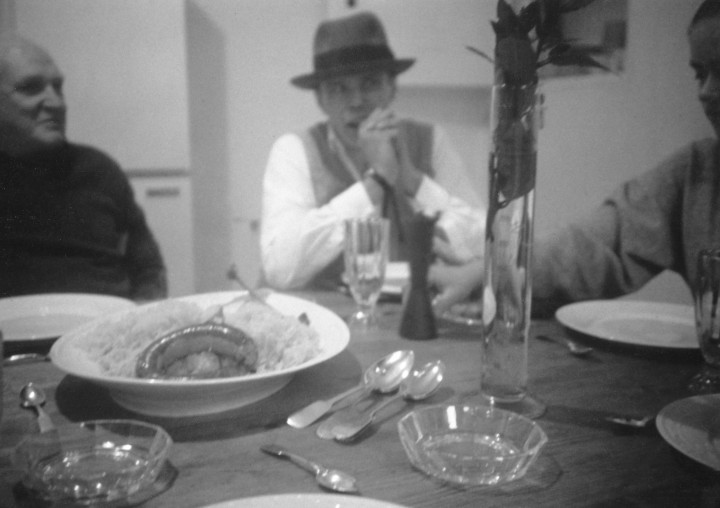Scottish Art News
Latest news
Magazine
News & Press
Publications
George Wyllie’s Centenary
By Jan Patience, 31.12.2021
.jpg)
I vividly remember the moment I saw George Wyllie's Straw Locomotive hanging from the jib of Glasgow's famous Finnieston Crane. It was 1987 and I hadn't long passed my driving test. I rounded a corner under a motorway flyover, looked up, and there it was. Art outside the gallery. I nearly crashed the car in surprise.
Even though at that point, I didn't know the name of the artist, it was clear to me what this straw train was saying. In the late 1980s, Scotland was in the grip of an economic downturn. Heavy engineering, in the shape of the building of locomotives and ships which were sent all over the world, had all but deserted the Clyde.
Tens of thousands of people in Scotland’s former industrial heartlands were unemployed. Wyllie's ‘Straw Loco’, followed two years later by a giant Paper Boat, launched with a fanfare from beneath the crane, gave this collective sense of loss a visual framework.
 George Wyllie, Straw Locomotive on Finneieston Crane, 1987.
George Wyllie, Straw Locomotive on Finneieston Crane, 1987.
In 1987, George Wyllie was a 67-year-old customs and excise officer turned full-time artist. His art training came from the school of life. Born a hundred years ago in Shettleston, Glasgow, Wyllie was a creative and energetic boy who grew into a creative and energetic man.
Wyllie loved the theatre, dancing, music and making "things which worked", but being an artist – or even a performer – was not something working class lads like him did in his day. His first job, in 1938, was as a delivery boy for a shipping company based near Finnieston. This Finnieston Crane, was then working at full tilt, loading Clyde-built railway engines and carriages onto ships below en route to far-flung destinations across the globe.
Wyllie trained as an engineer with the Post Office before joining the Navy and seeing active service in Europe and the Pacific during World War Two. He was one of a handful of sailors who witnessed firsthand the devastation caused when an atomic bomb dropped on the Japanese city of Hiroshima. Back home, with a wife and growing family, he worked as a water guard in Northern Ireland and Greenock for 30 years.
By the late 1980s, Wyllie had moved from making "crusty objects" and quirky eagles, dolphins and peacocks fashioned from old chrome car bumpers or abstract sculptures in mild steel for clubs, pubs and restaurants, to having solo exhibitions.
His first major exhibition was held in 1976 at the Collins Gallery, Glasgow. By then, Wyllie had started to mix with artists, including the irrepressible gallerist and artist, Richard Demarco. He called his show, 'Scul?ture'. "The question mark deliberately replaced the ‘p’ to signify doubt and apprehension", he explained.
 George Wyllie & Joseph Beuys at the latter's house in the mid-1980s.
George Wyllie & Joseph Beuys at the latter's house in the mid-1980s.
This question mark went on to become Wyllie's trademark. His friend, filmmaker, Murray Grigor, christened him The Whys?sMan in an award-winning film made for Channel 4 in 1990.
By the 1980s, Wyllie was a fixture on the Scottish art scene. An exhibition, 'A Day Down a Goldmine', at the old Third Eye Centre in Glasgow morphed into an award-winning two-handed play, starring George and various actors, including Bill Paterson and Russell Hunter. Combining the maturity of an older man with the energetic zest of an emerging artist, not to mention a penchant for showmanship and a razor-sharp wit, Wyllie was looked up to by an emerging generation of artists and creative people.
Artist David Harding, founder of the groundbreaking environmental art course at the Glasgow School of Art (GSA), invited Wyllie to work with students to ‘amplify’ their ideas on performance and installation. Together, they participated in a theatrical event based around the Berlin Wall and travelled to Rannoch Moor to erect a spire in remembrance of Joseph Beuys, the so-called "father of conceptual art", who died in 1986. Beuys and George, who were the same age, had met through Demarco and formed a close friendship.
GSA students Wyllie worked with included future contemporary art stars such as Douglas Gordon, Roderick Buchanan, Christine Borland and Ross Sinclair. George jokes he had to ‘wallop them a bit hard for being too conceptual’.
One of the problems with coming into your own later in life is that you cram in a lot into a small window of time. Wyllie spent more than 30 years as a full-time artist, writer and performer. His talent was to create punchy visual statements which touched people with their seeming simplicity.
There was always a message to Wyllie's medium; be that the loss of heavy industry, the damage we humans inflict on the earth, the need to ask questions or even just cocking a snook at the craziness of the art world.
 George Wyllie's Running Clock outside Buchanan Street Bus Station.
George Wyllie's Running Clock outside Buchanan Street Bus Station.
As he neared the end of a long life – he died, aged 90, in 2012 – Wyllie became obsessed with mutability, and the fact every human being is on a own cosmic journey through life and beyond.
Thousands of people every day hurry past Wyllie's Running Clock outside Glasgow's Buchanan Bus Station. It's a surreal sight to see this gawky shinily static clock on legs tower over passers-by, but it works. We are all running to stand still.
Recently a group of artists and makers, led by Willie Sutherland, a self-taught artist in his 50s, staged a vividly original reimagining of Wyllie's 1984 exhibition, 'Christmas Day Down a Goldmine', inside a barn like former weaving factory in Dalmarnock, Glasgow. Schoolchildren, twenty somethings and old stagers who knew Wyllie in his pomp all came together to be re-energised by the originality of his vision. Next year, a new gallery bearing his name will open as part of a new £15 million cruise ship visitor centre in Greenock.
Both celebrate and foster what poet Liz Lochhead, describes as Wyllie's 'seriously playful' approach to art. The Whys?sman may be gone, but he has an uncanny knack of asking questions from beyond the grave.
Jan Patience is a journalist and co-author of Arrivals and Sailings: The Making of George Wyllie (Polygon Books).




